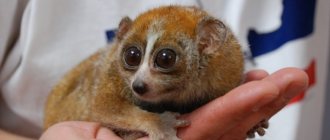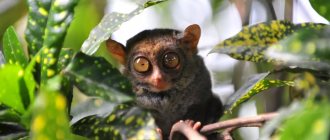24 June34951squad primateslemurendemic
The ring-tailed lemur (other names ring-tailed lemur, catta lemur) is the most popular species of the lemur family. The ring-tailed lemur is a member of the order Primates. In Madagascar, the ring-tailed lemur is nicknamed maki. Lemurs are very cute, funny and kind animals. Below you will find a description and photo of the lemur, and also learn a lot of interesting things about this unusual and mysterious animal.
Scientific classification
- Kingdom: Animalia (animals)
- Phylum: Chordata
- Class: Mammalia (mammals)
- Order: Primates (primates)
- Family: Lemuridae (lemurs)
- Genus: Lemur (ring-tailed lemurs)
- Species: Lemur catta (ring-tailed lemur)
Other names: catta, maki, ring-tailed lemur
What does a lemur eat?
The lemur mainly eats fruit. Therefore, we can say that the ring-tailed lemur is a vegetarian. In addition, lemurs feed on leaves and flowers, as well as herbaceous plants.
The lemur even eats cacti and occasionally insects. Lemurs often look for food on the ground, but they always try to stay close to trees so that in case of danger they can hide on them. Lemur catta is very careful.
Spread range
Geographical distribution
The only place where representatives of the superfamily Lemuroidea, including ring-tailed lemurs, can be found in the wild is Madagascar . Located southeast of Africa and separated from the continent by the 800 km wide Mozambique Channel, the island of Madagascar lies in the Indian Ocean and is the fourth largest island in the world.
Ring-tailed lemurs are found only in the southern and southwestern parts of the island, reaching the northern border near the city of Morondava on the west coast and the city of Ambalavao in the east. The southeastern border is the city of Tolagnaro on the southern coast.
Photo: Wikipedia
Ring-tailed lemurs were also introduced into the United States to St. Catherine Island , Georgia, as part of a project to establish a free-ranging population that could be studied and potentially used as a future stocking source for Madagascan parks.
There are almost 2,000 ring-tailed lemurs in captivity. The size of the wild population is unknown, with scientific estimates ranging from 10,000 to 100,000 individuals .
- Biogeographic regions: Madagascar
- Type of animal: island endemic
Habitat
Madagascar is an island 1,650 km long, divided by a mountain range that runs the entire length of the island from north to south. This mountain range divides Madagascar into eastern and western parts, each of which has a distinct climate, topography and vegetation. Ring-tailed lemurs are found in the southeastern part of the island at altitudes ranging from sea level to 2,600 meters in a variety of habitats, including tropical, subalpine, deciduous and gallery forests with thorny bushes.
Southwestern Madagascar is subject to periodic droughts, which in the future could lead to serious consequences for ring-tailed lemurs and other inhabitants of the island.
Much of the ring-tailed lemur's historic habitat has been altered by human impacts: clearing for agriculture, burning for charcoal, and clearing of forests to create settlements. Ring-tailed lemurs require at least some forest cover , so their distribution on the island is patchy.
- Terrestrial biomes: forest and bush
Home range
The average daily range of ring-tailed lemurs is about a kilometer, and one group will use the same part of the home range for three or four days before moving to another part of it.
Photo: Stephane Masson
The size of the home range varies depending on the habitat, and the average size ranges from 0.1 to 350 km². In drier areas, the size of personal territories is larger, averaging 32 km², compared to wetter habitats, where the catta has an average range of 17 km².
Poppies expand their habitats seasonally; During the dry season they use large areas due to lack of resources. The habitats of several groups of ring-tailed lemurs overlap, and there are several areas that are used exclusively by one group.
Population density is also related to habitat quality. Wetter areas have more ring-tailed lemurs per square kilometer, up to 350 individuals per square kilometer, compared to drier areas where densities can reach 17 individuals per square kilometer.
Habitat of ring-tailed lemurs
The habitat of these mammals is located in the southwest and south of the island of Madagascar. Here they live from Mondradov on the west coast south to Fort Dauphine. There is also a small isolated population on the southeastern plateau in the Andringitra Mountains.
Lemurs are slender animals, comparable in size to cats.
Character traits
Appearance
A striking distinctive feature of the catta is its long tail, about 60 cm in size, on which stripes of black and white rings alternate. The rest of the body is light reddish-gray to dark reddish-brown in color, with light gray or grey-brown limbs.
Ring-tailed lemurs have a white belly and inner limbs. These primates have white faces with dark brown or black triangular spots around the eyes that look like a mask . The eyes are light brown. The tip of the muzzle is black. The catt's ears are white and angular, similar to a cat's.
Photo: Rafael Medina
Male ring-tailed lemurs have dark scent glands on the inside of their wrists with a spur-shaped nail, commonly called a horned spur . Males also have scent glands on the chest, just above the collarbone and near the armpits, as well as anogenital scent glands.
Ring-tailed lemurs have unique dental characteristics compared to other members of the superfamily Lemuroidea; they have special teeth in the lower jaw that form a dental comb . These long, narrow teeth protrude almost straight from the jaw, and this specialized dentition is thought to aid in self-care.
Dimensions
Males and females are approximately the same size, in the wild they measure about 42.5 cm from head to rump and weigh an average of 2.2 kg. In captivity, ring-tailed lemurs weigh slightly more than their wild counterparts, with males averaging 2.7 kg and females 2.68 kg.
- Body length: 39 to 46 cm
- Tail length: 56 to 63 cm
- Average weight: 2.2 kg
Baby lemur
The mating season for the ring-tailed lemur occurs in late winter and early spring. At this time, male lemurs put on truly acrobatic shows on tree branches and fight each other with the “stinker” of their glands. The lemur animal gives birth to offspring every year. The ring-tailed lemur becomes capable of reproducing offspring at the age of 2-2.5 years. But in its young years, the animal lemur has tough competition with older males. Therefore, young catta lemur males will have a chance to have offspring only at the age of 5 years.
Only 1 cub is born to the ring-tailed lemur, and twins are only occasionally encountered. A baby lemur is born in August-October. The catta lemur's gestation period is approximately 220 days. A born lemur cub weighs from 80 to 120 grams.
Immediately after birth, the baby lemur clings to its mother's fur and hangs on it. For the first few months, females carry their babies on their stomachs; later, the baby lemur moves onto their back.
Already at 2 months, the baby lemur decides to leave its mother’s back for the first time to take short walks. But he still returns to his mother to eat and sleep. Up to 5 months, the female feeds her cub with milk.
By 6 months, the baby lemur becomes independent. Ring-tailed lemurs can live to be almost 40 years old, but this rarely happens in the wild.
Don’t forget to subscribe to updates on our website and join us on social networks (Vkontakte, Odnoklassniki, Instagram) so you don’t miss anything and always stay up to date with all the news!
Don't forget to share with your friends!
Diet
Due to the seasonality of their habitat, wild ring-tailed lemurs must utilize a wide variety of food sources throughout the year. They are best described as opportunistic omnivores . They eat ripe fruits, leaves, stems, flowers, exudates, spiders, cobwebs, caterpillars, cicadas, insect cocoons, birds, chameleons, grasshoppers and even dirt from termite mounds.
One of the most important food sources for maquis is the Indian date , which provides the animals with a reliable, year-round source of food. Dates can provide up to 50% of food requirements and are considered a keystone food source for ring-tailed lemurs.
In the driest parts of the range, water availability is a potentially serious problem. Ring-tailed lemurs are able to obtain water from succulents (aloe and cactus), dew on leaves and water accumulated in crevices, such as tree hollows.
The presence of vegetation is directly related to the amount of precipitation. During the rainy season, from approximately October to April, fruits and young leaves become available to ring-tailed lemurs. There are two peaks in fruit availability: October to November and March to April. During the dry season, dates are practically the only source of fruit. The availability of flowers peaks before the onset of the monsoon and is another important food source. During the dry season, even mature leaves may be scarce, and ring-tailed lemurs eat dry, dried out leaves, which are more difficult to digest. This is the period of greatest nutritional stress for animals.
Lifestyle and behavior
Ring-tailed lemurs are the most terrestrial of all lemurs. These primates walk or run on all fours, with the tail held almost completely vertical when moving, with the tip curving to form a question mark shape .
One group splits into two sleeping groups each night, snuggling together as they sleep. They begin their day by waking up before dawn and gathering in open areas of the forest. Until about 9 a.m., ring-tailed lemurs “sunbathe . Ring-tailed lemurs sit with their bellies facing the sun and their limbs extended to the sides. This position provides maximum exposure to the sun's rays on the body, which has cooled down after a cold night or cold morning.
The animals then go in search of food. The group again settles down in the shade for a short period of rest in the afternoon, although on the hottest days this is extended to 4 hours. After intensive feeding in the afternoon, the entire group returns to the "sleeping" tree, where they remain all night, but during this time individuals can move around the tree, groom themselves and interact with other members of the group. Thus, poppies are active throughout the day .
Appearance and features
Photo: Ring-tailed lemur from Madagascar
Lemurs look like monkeys from another planet. Because of their large eyes, painted with dark circles, they resemble aliens. They can be considered relatives, but they are completely different animals and differ in many characteristics. For a long time, wet-nosed primates were mistaken for prosimians. The main difference with primates is a moist nose like a dog’s and a very well developed sense of smell.
Ring-tailed lemurs are easily recognized by their long, bushy tail, which is decorated with black and white alternating ringed stripes. The tail is raised like an antenna and curved in a spiral. With the help of their tail, they signal their location, balance on trees and when jumping from branch to branch. Lemurs need a tail during “smelly” fights, during the mating period. If it is cool at night or early in the morning, then the animals warm themselves with the help of their tail, as if they were putting on a fur coat. The tail is longer than the animal's body. Approximate ratio 40:60 cm.
Lemurs are slender, fit - ready for action like cats. Nature has endowed these animals with beautiful colors. The color of the tail appears on the face: black near the eyes and mouth, and white cheeks and ears. The back can be gray or brown with shades of pink.
The inside of the ring-tailed lemur's body is elegantly covered with white fur. And only the head and neck are completely dark gray. The muzzle is sharp, reminiscent of a fox. The coat is short, thick, soft, like fur.
There are five toes on the paws, the anatomy of the limbs is like that of monkeys. Thanks to this feature, lemurs tenaciously hold on to tree branches and easily retain food. The palms are covered with black skin without hair. Cattas have nails on their toes and only the second toe of their hind legs grow claws. Animals use them to comb their thick fur. The teeth of lemurs are located specifically: the lower incisors are noticeably closer and inclined, and there is a large gap between the upper ones, located at the base of the nose. Typically, lemurs of this species weigh 2.2 kg, and the maximum weight reaches 3.5 kg, with the weight of the tail being 1.5 kg.
Social structure
Ring-tailed lemurs live in groups consisting of several males and females, numbering from 11 to 17 individuals. a strict matriarchal hierarchy within the group , as females almost always remain in their natal groups while males migrate to a new group.
Photo: Duke Lemur Center
Adult females are always dominant over adult males, reinforcing their dominance through agonistic encounters including lunging, chasing, grasping and biting the males. Submissive responses to such aggressive behavior include jumping, running, and squealing. The hierarchy among female ring-tailed lemurs is not linear; daughters do not inherit their mother's rank , but independently fight for their ranking.
Males have a separate dominance hierarchy from females. The ranking among males correlates with age. The main males are usually in their "prime", between six and nine years of age.
When a group of ring-tailed lemurs moves from one place to another, the procession is led by females, juveniles and dominant males, while lower-ranking males bring up the rear of the group. When the group reaches its destination, either resting or feeding, low-ranking males continue to remain on the periphery of the group, foraging alone or resting together.
One of the benefits of being a high-ranking male is increased social interaction with dominant females, which can provide benefits such as:
- reducing the risk of predation;
- greater access to food resources;
- greater chance of mating with reproductively receptive females.
Communication and perception
Photo: Rafael Medina
Olfactory, visual and vocal communications are important for ring-tailed lemurs. They are one of the most vocal primates . They have 28 different types of calls, 22 of which are used by adults, six by babies. Their calls can be heard at a distance of 750 to 1000 meters.
In addition to this, ring-tailed lemurs use a variety of visual cues, including body posture and facial expressions. They also have scent glands on their wrists and chest, which are used to mark territories.
Direct competition between males is high during the mating season. During a "smelly fight" males rub their tails against the inside of their wrists and chest. They then arch their tails over their body and wave them towards the enemy. The male at whom the tail is pointed either responds with a display of physical aggression or runs away. “Smelly fights” can last from 10 minutes to one hour.
Reproduction
Breeding season
The reproductive success of ring-tailed lemurs depends largely on environmental conditions. During exceptionally favorable years in the wild, the age of maturity occurs earlier, and birth rates and infant survival rates are much higher compared to dry years. In normal years, males and females reach adult size before they are three years old and do not reproduce until they are 2.5 to 4 years old.
Females are sexually receptive for one to two days a year, and estrus can last from 6 to 24 hours. In the wild, the breeding season occurs in May and lasts 7-21 days. Males and females can have multiple partners . During these few weeks, males approach females to inspect their genitals and attempt to mate. Unresponsive females will act aggressively towards males, driving them away. The estrous female boldly approaches the male for mating, standing with her back to him, raising her tail and looking at him over her shoulder.
Photo: Pinterest
Due to the harsh conditions, ring-tailed lemurs have high fecundity . Gestation lasts between 135 and 145 days, and females in the wild almost always give birth to a single calf. In captivity, the birth rate of twins and triplets is higher. Between 75 and 80% of adult females give birth annually, and the average interval between births is a year. These high rates of reproduction are allowing ring-tailed lemur populations to recover from years of high mortality associated with environmental stress. For example, during drought years, infant mortality can reach 80%, while normal infant mortality within one year of birth is about 37%.
- Mating system: polygamy
- Breeding interval: once a year
- Breeding season: May
- Gestation period: 19-20.5 weeks
Cubs development
The timing of births coincides with the end of the dry season and the beginning of the rainy season, with the highest number of births occurring in September. During such periods, food is plentiful, so some of the physical stress associated with breastfeeding and weaning can be minimized.
During the first days of life, maquis cling ventrally to their mother , but by the third day they can actively move around her body. By the age of one month, the cubs begin to independently explore their surroundings, spending about 16% of their time without their mother. Although at this age they still do not dare to go further than half a meter from their mother.
Social play with peers begins around the sixth week of life and includes chasing, biting, jumping, etc. As the baby grows older, he spends less time nursing and more time searching for food. Weaning begins at the eighth week.
Mothers allow everyone in the group to babysit their young because it benefits everyone. Mothers are given time to rest and can feed and travel more efficiently if another ring-tailed lemur handles their young, while the young learn valuable social skills, gain additional protection from predators or conspecifics from other groups, and can potentially form relationships with adult females, which will influence their future position in the group. “Nannies” also win. Males gain social access to adult females, potentially securing future mate status; nulliparous females gain valuable experience with babies.
Photo: ZooBorns
If a cub is orphaned before weaning, group members provide care for it, including carrying it on their back and nursing it. Cases of abduction have also been observed among ring-tailed lemurs. The adult female, acting as a parent, holds the baby and, together with other females, prevents the mother from taking it away. In some cases, the kidnapper accepts the cub as his own, while in other cases he simply prevents the mother from taking the child, does not care for it, and the cub subsequently dies.
- Average number of offspring: one cub
- Average weaning age: 5 months
- Average time of independence: 1 year
Lifespan and predation
In the wild, female ring-tailed lemurs rarely live past 16 years, and the oldest known wild female was about 20 years old. The lifespan of males is even less known due to the social system, but they have been recorded to live to at least 15 years. In captivity, life expectancy sometimes reaches 27 years.
Predation pressure can come from fossa, civet, marten and various snakes. Brown lemurs catch and eat baby maquis. Domestic cats introduced to Madagascar are also responsible for the demise of these primates.
Origin of the species and description
Photo: Ring-tailed lemur
The word "lemur" means evil, ghost, spirit of the dead. According to legend, harmless animals are undeservedly called evil only because they frightened travelers from Ancient Rome who first visited Madagascar. The Europeans sailed to the island at night and were very frightened by the glowing lights of the eyes and the eerie sounds that came from the night forest. Fear has big eyes, and since then the cute animals on the island have been called lemurs.
The ring-tailed lemur belongs to the lemurid family and is also the only representative of the lemur genus. Maquis are mammals, lower wet-nosed primates from the lemur family. It is the wet-nosed primates that are among the most ancient primates on our planet. They can deservedly be called the aborigines of Madagascar. Scientists have noted, according to the fossilized remains of ancient lemurs, that the first lemur-like primates lived 60 million years ago in Africa.
Video: Ring-tailed lemur
When Madagascar moved away from Africa, the animals moved to the island. In total, there were more than one hundred species of lemurs. With human intervention in the habitat of primates, the population of these animals began to decline. 16 lemur-like species have disappeared.
Three families of lemurs became extinct:
The largest species of lemurs, which were similar in size to a gorilla and weighed up to 200 kg, disappeared the fastest. They led a mainly diurnal lifestyle. They were clumsy. They became easy prey for hunters of those times - connoisseurs of meat and high-quality skins of these primates.
Species of lemurs that have survived to this day are divided into five families:
Today the island is home to about 100 species of lemur-like primates. The smallest is the pygmy lemur and the largest is the indri. More new species of lemurs are being discovered and another 10-20 species will be described in the future. Lemurids have not been studied enough in comparison with other primates.











